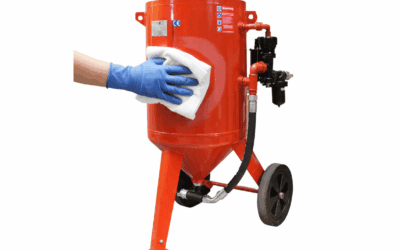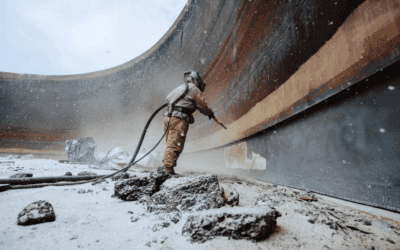What are blast pots used for?
Blast pots are used to prep or treat surfaces before coating, remove corrosion, and clean or deburr surfaces.
Otherwise known as blast machines or sandblast machines, there are numerous types and sizes available, all with different properties and specific uses; however, when the term blast pot is used, it refers to dry pneumatic blast machines. The blast pot itself is a pressurised vessel containing abrasive media. When the blast pot is connected to a compressor, it propels the abrasive down a hose and out of a nozzle, which the operator handles.
How are blast pots used in industry?
Grit blasting with a blast pot has been utilised as a tool for surface treatment globally for over a century. Compared to other modes of abrasion, such as direct abrasion, grit blasting with a blast pot remains the most efficient and effective methodology.
Blast pots can come in many variations and sizes and, dependent on the configuration, are used for specific processes. As a result, they are used in many different industries, including; OEMs, civil engineering, energy, renewables, rail and road, marine, aerospace, and defence. Below is a list of examples of how blast pots are used in various industries.
OEMs
For original equipment manufacturers, blast pots are utilised inside of a larger surface treatment solution, a blast room. Blast rooms are enclosed, ventilated spaces where abrasive blasting occurs in a controlled and safe environment. Inside, operators handle the blast pot’s blast hose and its nozzle to process product in preparation for later coating.
Areospace
Similarly to OEMs, blast pots are used to treat aircraft inside a specialised blast room before coating in the aerospace industry. In these technical blast rooms, either whole aircraft or aircraft components are processed. Moreover, aircraft require exacting surface specifications before coating, so blast pots use specialised abrasive material, plastic media, that creates a profile on delicate surfaces at lower pressures.
Marine
Blast pots treat ship hulls for corrosion and damage in shipyards before being repainted with anti-foul coating. For especially large ships, scaffolding is erected, or operators use suspended platforms to gain coverage and process those ships’ hulls. Typically in shipyards, blasting is carried out outside a blast room with expendable abrasives, such as slag grits.
Rail
For manufacturers in the rail sector, such as Hitachi rail, blast pots are used to treat rail stock before coating it in a spray booth. These blast pots are used in conjunction with a bespoke blast room. These blast rooms are designed and installed with integrated rails on which the rolling stock can be manoeuvred. Moreover, the blast room’s floor can be lowered so operators can treat its undercarriage.
Contractors
Contractors use blast pots to provide specific services, such as cleaning and preparing metal for coating, building restoration, etching, art projects, paint stripping, and oxidation removal.



